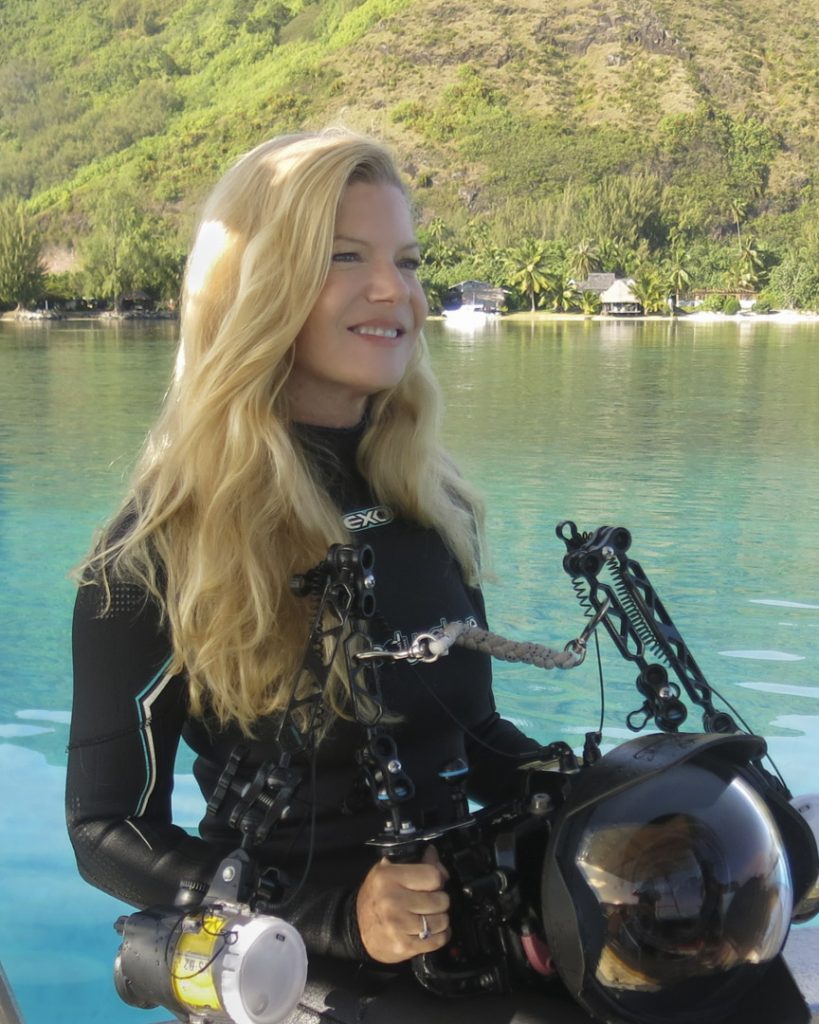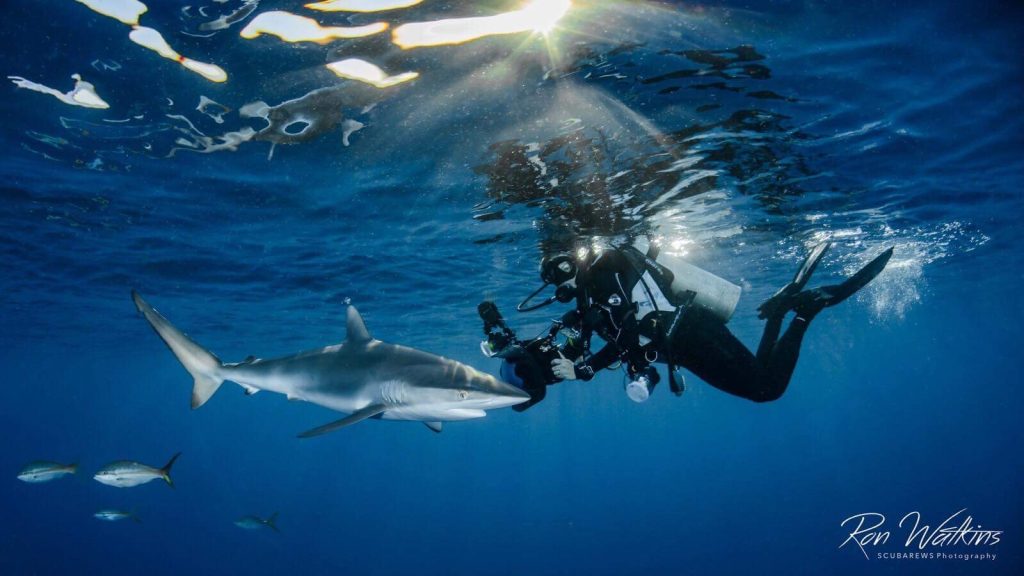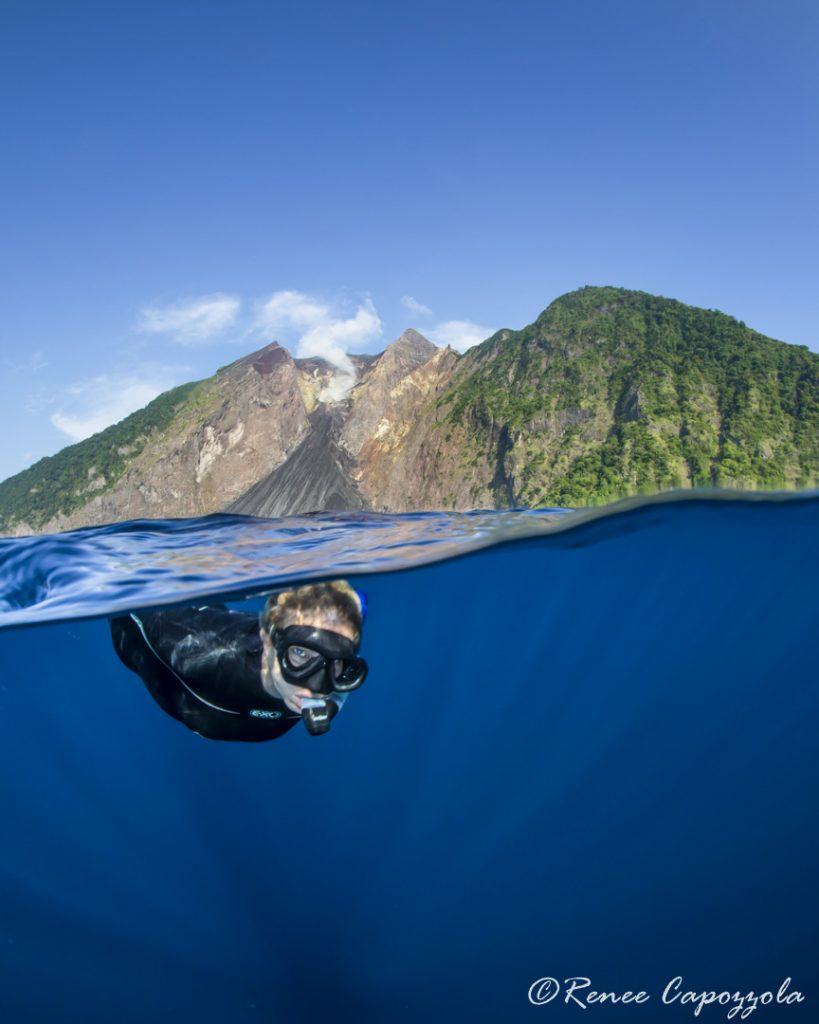Maui Resident Wins Underwater Photographer of the Year in Contest with 4,500 Images from 68 Countries
During a 2 ½-week trip in August to the French Polynesian island of Moorea, Maui resident Renee Capozzola patiently waited for optimal conditions of calm water, light wind and a gorgeous sunset.
When that trifecta was in place, she stood in 4 feet of water with about a 35-pound underwater camera system, patiently waiting again – this time for blacktip reef sharks to cooperate.
The patience paid off. Two 4- to 5-foot-long marine creatures swam perfectly into her frame, along with two flying seabirds.
She submitted the best image of that fleeting moment, along with a few other photos taken during the past year, to the 2021 Underwater Photographer of the Year competition based in the United Kingdom.
To Capozzola’s shock and delight, “Shark’s Skylight” beat out more than 4,500 images submitted from photographers in 68 countries. She also became the first female in the male-dominated field to win the prestigious contest that started in 1965 (although there were years it was not held).
The competition judges described the winning image as “a sunset ballet of reef sharks and sea birds in a tranquil corner of the Pacific Ocean.”
Capozzola had done much preparation to perfectly capture this moment that was gone in a flash. She had scouted the location. Took pictures there. Analyzed them. Tweaked her camera settings. And repeated it all. So when the moment arrived, she was ready with the right lens (a wide-angle 11-24 mm), ideal camera settings, proper strobe angles to prevent backscatter, and the correct-sized dome housing to capture split-level photos that depict a scene half above the water and half under it.
“It’s a real art to create images that are contest worthy or publishable,” renowned underwater photographer Ron Watkins said. “No shots Renee gets are flukes. Sometimes people do well in a contest because they had a particularly good day on a particular dive. Her images are consistently of high quality.”
When entering the contest, Capozzola didn’t think the shark image was her best. “I thought this was my best shot,” she said while clicking an image on her laptop that showed three sea turtles with a starburst in deep blue water.
“I took that at Mala, Maui’s kind of signature dive site,” she said during a recent interview poolside of a rented condo in Napili, where she is staying during the COVID-19 pandemic with her remote-working attorney husband and their two boys who are attending Maui Preparatory Academy.
Capozzola already knew Maui well from all the vacations she took here as a child when her father worked for airlines, and from the 2-3 trips a year she took here with her husband and children.
One lure is the turtles. She described how she got her recent magical turtles image with the starburst: “When the conditions were good, I’d just hang out at the cleaning station, at about 12 feet, floating at neutral buoyancy and just wait for the turtles to do something. I could sit there for 90 minutes and maybe only take 12 pictures the whole dive. I didn’t want to scare them away.”
The turtles image also won an award in the interanational contest — honorable mention (4th place) in the wide-angle category.
Not bad for an AP biology teacher who is basically a self-taught photographer. In 2013, she was still using a compact Olympus camera to capture the marine environment simply to share with friends and her parents who don’t dive. She laughed about flooding an ungraded SeaLife camera during its maiden use because a string got caught in the O-ring. She didn’t get her first strobe, which brings back the reds and other colors lost under water, until 2014.
And, she didn’t purchase her first DSLR camera with changeable lenses and intricate settings until 2016, and only then because she got a good deal on a used setup.
Since then, she has risen at the speed of a breaching mama humpback whale in the world of underwater photography – with more than 40 international awards. Her photos also have graced the cover of six magazines, including Ocean Geographic and Scuba Diving Magazine.
Watkins, who also is a trip leader, gear reviewer and workshop instructor with Backscatter Underwater Video & Photo, has watched Capozzola’s fast progression. They met during monthly socials for Blue Water, an underwater camera store in Southern California, where they both were living at the time.
“I’m an instructor and teach a lot of people underwater photography,” Watkins said. “After I explain a concept, they either get it or not. Renee was relentless. I’d talk about something and two days later she went out to [Santa] Catalina Island to try it. Once she gets a hold of something, she had to perfect it – and then take it to another level. That’s when I could really tell she was special.”
It helped that Capozzola already knew a lot about composition due to her artistic background with oil painting. Although on the technical side, she started from scratch with little knowledge about aperture, shutter speed or ISO.
But now, after endless hours of absorbing like a sponge all she could about underwater photography from reading books, watching videos, trial and error, and asking questions of other photographers, she’s become a technical whiz – and trying to learn more on every dive.
“It’s not like birding, when you sit in a field and wait for a bird to land,” Watkins said. “It is very dynamic under water. She has great instinct and can respond very quickly. She also is so good with her equipment. A lot of photographers fumble with their gear and miss the moment.”
Capozzola first experienced the underwater world in 2004, when she and her husband went to Molokini Crater off Maui to try SNUBA (breathing underwater through a regulator that is connected to an air supply floating on the surface).
They loved it so much they tried a PADI Discover SCUBA excursion with Lahaina Divers. “Our instructor Kai took us around the Mala area,” she recalled. “The highlight of the dive was interacting with a large sea turtle, obviously an older one. The turtle came and checked us out. After that, I was totally hooked.”
For more than a decade, she took photos for fun, starting with a simple film underwater camera that required advancing after each shot. When she became more serious about the photography, Capozzola, as a biology teacher, also wanted to write articles for SCUBA diving magazines. She became frustrated when the magazines showed little interest.
To get published, Capozzola figured there were two doorways: social media or contests. Due to her competitive nature, which included running track at UCLA, she focused on contests.
In 2016, the year she got her first DSLR camera, she organized a US team to compete in the World Shootout Underwater Photo Grand Prix. She enlisted Watkins and Jeff Milisen, also a renowned international award winning photographer from Kona-Kohala on the Big Island.
Milisen literally wrote the book about blackwater photography (shooting tiny sea monsters at night). Watkins was the “jack of all trades.” And Capozzola specialized in wide-angle and split-level photos. The team won. It was Capozzola’s first contest win. She also won second place in the shark category of that contest.
Capozzola is happy that her two latest photo awards were shot in locations where strong government conservation efforts have led to thriving populations of threatened species.
“One of the best things about French Polynesia, besides being beautiful, is they have done such an amazing job at legislating the protection for their sharks,” she said. “There is no shark fishing. No shark finning. They are strict and enforce the rules. People who live there care about the sharks. And, they see the sharks as being important to their culture and marine eco system.”
It’s a different story around much of the rest of world, with sharks threatened and many species on the verge of extinction.
“We don’t even know how many sharks are killed each year,” she said. “Most [scientist’s] numbers are between 70 to 100 million sharks and that is not sustainable. Sharks are older than dinasours, over 450 million years old and the top predator of the marine ecosystem. They balance everythign underneath it, so if you take out the shark, or any link in the food chain or food web, you mess up the whole eco system.”
She hopes her beautiful photos of sharks will encourage more people to help protect them, just as she hopes her endearing photos of sea turtles will do the same for them.
Capozzola told the story about her friends who run a dive operation in Papau New Guinea, where there is a big problem with villagers eating sea turtle eggs to the point of “nearly wiping them out.” To help, her friends and others go to nearby islands when the turtles lay a nest of eggs and take them to the island at the dive resort to rebury them. When they hatch, they release them.
“I hope my photos at Mala help highlight Hawaiʻi’s success story of what they have done to protect turtles,” she said.
Capozzola has traveled to some of the best dive sites in the world, including the incredibily biodiverse Coral Triangle, a marine area in the western Pacific Ocean that includes the waters of Indonesia, Malaysia, the Philipines and Papua New Guinea. She’s also dove in waters off Thailand and Cuba.
And she was “amazed” during her trip to Lamalera in Indonesia, where villagers still hunt whales with wooden poles.
Capozzola has done her fair of shooting whales, but with her camera. She said there are basically four places in the world where photographers can legally swim — albeit with restrictions — with the marine mammals: Moorea, Tonga, Dominican Republic and Reunion Island in the Indian Ocean.
“I go to Moorea almost every year to shoot humpback whales,” she said. “You can’t use flash. They are so big and you are not supposed to with mammals.”
She said it is important not to swim after the whales and stress them out. “We let the whales come to us,” she said. It led to an award-winning photo of a whale with its eye “checking us out.”
Erica Watson met Capozzola in Tahiti on a dive trip about eight years ago, when Capozzola was still using her compact camera. They became friends and Watson also watched Capozzola quickly perfect her craft: “She kept getting better and better.”
Watson said one reason Capozzola gets such great shots is she gets a particular shot in her mind and then works hard to make it happen.
“We were in Indonesia and Renee wanted to shoot a split-level image of me free diving with a volcano in the background,” Watson said. “It took two hours. I was dog paddling in the water. It was pretty hilarious. But she had to make sure my eyes were in the right place. It was the right depth of water. The wave was not too far up the dome. … I think that picture has been published four or five times.”
Watkins also became good friends with Capozzola and has traveled with her to several diving destinations around the world. He recalled the time “Team Breach,” the nickname a group of six divers gave themselves, were in Moorea on a little boat searching with no luck for whales.
“We were all frustrated, and then Renee puts Pringles in her mouth to look like duck lips and brought the mood back to having fun,” he said. “But when she’s in the water, her mindset is to do what it takes to get the great image. And she’ll keep trying until she does.”
Capozzola’s underwater photography can be viewed on her Instagram account @rcapozzola or website: beneaththesurfaceimaging.com.



















